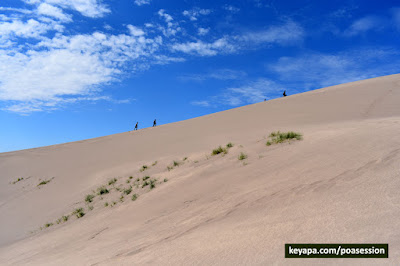The huge dunefields of Great Sand Dunes National Park in Colorado, which feature sand dunes up to 200 meters tall, is a tough place for any plant to survive. It is dry, the dessicating winds are harsh, and the threat of being buried by the ever shifting sands is a daily battle for those few organisms that make this area their home.
I visited this National Park in September 2019, and the first plants I noticed as I entered the dunefield was
Psoralidium lanceolatum (lemon scurfpea), which formed large colonies along the sandy perimeter of the actual dunes.
 |
| A colony of blowout grass |
This legume gave way to
Redfieldia flexuosa (blowoutgrass), which was the most common species I encountered as I slogged my way deeper into the sandy depths of the dunefield. As indicated by their common name, blowout grass tends to be found in the sandy depressions between dunes called "blowouts." However, I also found them high up the sides of tall dunes, clinging improbably to the sand in almost vertical colonies.
 |
| A colony of blowout grass clinging to the side of a dune |
I did not encounter individual specimens of this species in the dunes, but small to large colonies, a possible consequence of the fact the grass has fast growing rhizomes that allow it to quickly spread.
The rhizomes grow at varying depths, which might be an adaptation to the constantly fluctuating height of the sand dunes. Entire plants can be regrown from the rhizomes, even if they are buried deep in the sand.
 |
| Habit of blowout grass |
Blowout grass is readily identified by the presence of very fine panicles, which can be up to half the height of the plant. I took in situ macro shots of the spikelets, which are awn-less and have equal length glumes and two to six florets. The strong winds and fine sand particles that continually threatened to grit up my camera made the going rough, but I was happy with the results.
In the end, I really enjoyed finding and taking photographs of the blowout grass. It reminded me of the tenacity and adaptability of life, even in the harsh dry environment of the sand dunes. If I had more time, it would have been interesting to map out the locations of all the
R. flexuosa colonies in the various dunes.









No comments:
Post a Comment